You will notice that many performance motorcycle tires not only are available in different sizes, but ALSO specifically for the front and the rear of the motorcycle. Sometimes, manufacturers may also have the exact same size of tires for the front and the rear of the motorcycle, leading some to ask – are they the same? If they are the exact same size, can I use a “rear” tire for the “front” or vice-versa?

In short, the answer is a big NO! Performance motorcycle tires that are manufactured specifically for the front and the rear of the motorcycle may not only have different tread patterns, but also different tread pattern directions. Take a quick look at the set of Pirelli Angel CT’s mounted on my Pulsar 200NS. Both pictures were taken from the front of the motorcycle.
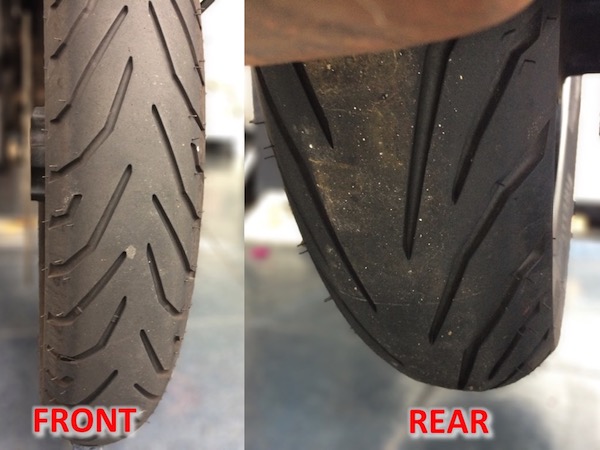
In such tires, not only is the FRONT and the REAR stipulated, the direction of travel is also inscribed onto the side wall. For proper installation, you’d want to install in such that the tires are rotating in the correct direction of travel when the motorcycle is moving forward.
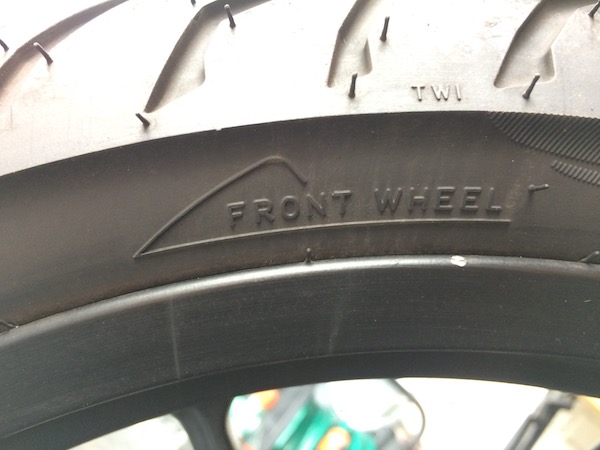

The next question then is, why is it designed as such? The main reason is that the front and the rear tires experience different forces. The rear tire is primarily used for acceleration and propelling the motorcycle forward. Whereas the front tire experiences the greatest forces during braking. And thus, the treads are designed with these primary forces in mind.
Let us first take a look at the tread pattern on the rear tire. As the motorcycle propels forward and the tire rotates, and if the road was wet, the grooves on the rear tires are designed to “push water to the side”. This makes perfect sense as you want minimal water to get trapped between the road and the tire surfaces to maximize grip.
Then the logical question to now ask is – why does the front tire then appear to “push water to the centre” as the tire is rotating forward? Wouldn’t then this cause aquaplaning? What are the design engineers even thinking?
1. AERODYNAMICS
Firstly, you need to understand that aquaplaning affects motorcycles and cars in slightly different ways. At similar speeds, cars are more prone to aquaplaning as compared to motorcycles. Why? This is due to the vastly different shapes of the 2 vehicles.
Without going into the specifics of Bernoulli’s Principle, cars are shaped very much like airplane wings – also known as aerofoil (British) or airfoil (American).
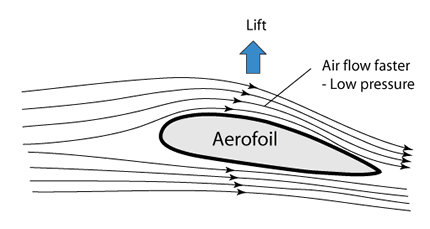
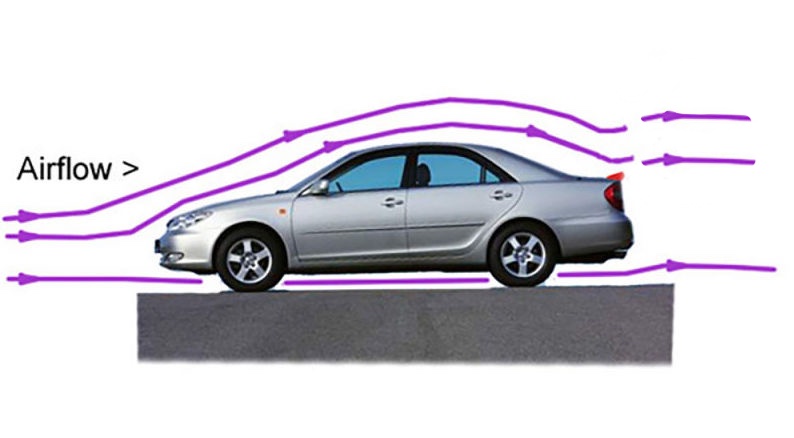
At higher speeds, cars get “lifted” due to the pressure differences at the top and bottom of the vehicle as it passes through air. This explains that “feeling of floating” that many divers experience at higher speeds. Motorcycles experience this too, but to a much lesser degree. And the lift forces seem to just about sufficient to pull up the rear of the rider’s shirt and expose his Calvin Klein underwear, but not enough to lift the motorcycle. And thus, motorcycles experience less aquaplaning due to lift forces as compared to cars and other heavy vehicles.
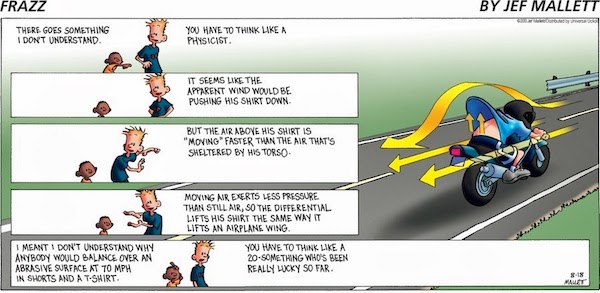
2. HYDRODYNAMICS
Motorcycle riders all know that the front brakes are responsible for about 70% of braking forces. Now, if you hit the brakes hard enough, you’ll experience a force of being “jolted forward”. That’s momentum – a force you experience because a moving body tends to want to continue to move forward unless opposed by another force.
Recall that the forces experienced on the rear wheel (acceleration) and the front wheel (braking) being different? Now, imagine during hard braking, any water trapped in those tire grooves and between the tires and the road surface, experience the same momentum forces too. It would “want to continue” in the direction of travel. And because of this force, the front tire’s groove pattern “forces” the water away from the centre of the tire, thus INCREASING road to tire surfaces grip – especially important for braking in wet roads.
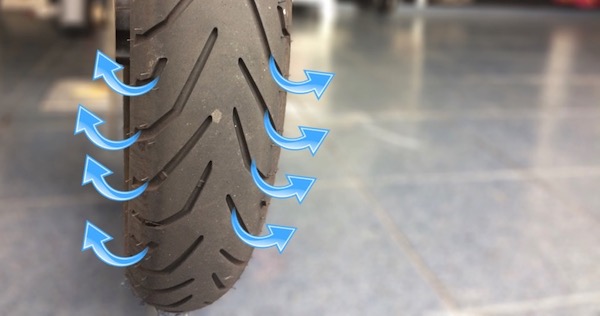
Now that you know how the front and rear tire treads of some uni-directional performance motorcycle tires work, ALWAYS check your tires when getting them installed. Make sure that the front and rear tires are where they should be, and that they are mounted in the correct direction of rotation.
Especially, especially more so for the front tire – it might just save your skin when braking on a wet day.

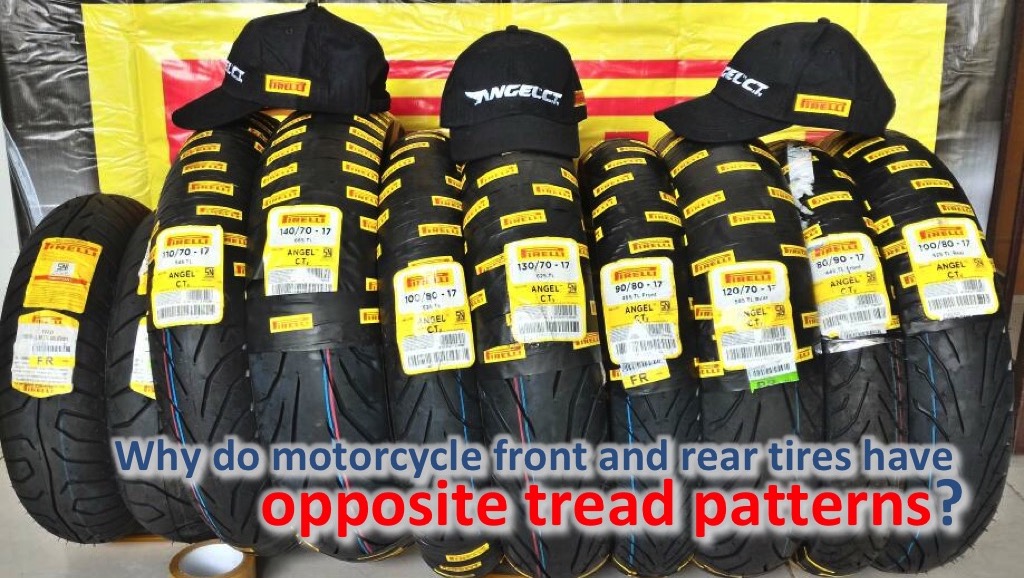
Question. Ok, that seems reasonable to put the front thread backwards. But, how many times do we brake on a wet road? Only once in a while right? I mean, the front tyre wont push the water aside if we are not braking, like when we are on a highway, we wont be using the brake for quiet a long distance. Thus, the thread will be pulling the water in between instead of pushing it aside. So, the question is, will the ‘backwards’ front thread have a downside when we are crusing on a moderate speed? Aquaplaning especially.
Heya. It’s really not about “how many times we brake on a wet road”, but more of where the forces are concentrated at. During acceleration (and cruising), the rear wheel drives the bike and the forces are predominantly on the rear tires. Vice-versa for braking. The unidirectional tread pattern does exactly that.
Now I don’t profess to be extremely knowledgeable in this, but I’m pretty darn sure the engineers in these tire companies know what they’re doing when designing performance tires, and have probably thought this through.
Plus, science.
I dont want to hydroplane, I just want to rocket up to speed and fly. The less I feel the road the better.
from what i know the tread difference between front and rear tyre is that if the tyre on the front is dispersing the water outward it will affects the handling due to the water resistance thus causing the front end of the bike to sway to the side.
follow up comment
-if the groove was dispersing water outside the bike will have extremely high wind and water resistance when you brake or just cruising the bike handling will affect by both 2 factor and “magically” turn your bike for you and you will also “magically” find yourself on the road sliding instead on your bike….hope this help.
Totally agree it’s for traction.
If the rear tread forces the water outwards for traction , then with the front tread in the opposite direction then forcing the water to the middle of your front tire wouldn’t that make your steering a little unstable?
If you are not breaking, then you are accelerating and front tire wont have contact with road…
Acceleration forces are not provided by the front wheel – it comes from the rear wheel.
I like your style
Tread, not “thread”.
It’s not all just straight riding. Think about the fact that you actually counter-steer the front wheel to control the motorcycle… Think about how the grooves in the tyre are displacing water at a lean angle? If the grooves are the same as the rear tyre you’re not displacing the water with the front tyre. Your front tyre counter-steering at a lean angle would appear to static water as grooves straight across the tyre, thus not displacing water. But with what appears like a backwards tread pattern this is abated and water is displaced.
Hey, I find your blog was very interesting and useful. Just made my decision on the Motul 7100 by reading your review of it.
This may not related to the topic, but may I know your experience with the Pirelli Angel CT? Is it good though?
Thanks! Keep it up!
It has so far been nothing but excellent with the Angel CT!
Thanks for the response!
You’re welcomed!
I have a totally different theory. First of all, the rotational speed itself makes sure that no water remains in the grooves while rotating.
The front tire “opposite” rotation helps push the water to the outside of the corner. This way it leaves the inner part free of any extra water that could cause you to spin when you lean even more. The rear tire doesn’t have such issues because it already moves on top of a “dry” corridor created by the front tire
Totally plausible.
then why rear tyre tread is pointing forward?
also
Michelin 22 model
rear tyre tread is pointing rearward and front tyre tread pointing forward….
also because of the shape of the moto tyres have a tube shape when rotating water ALWAYS travels from side to center due to centrifugal forces….
this is really frustrating…
I love physics I understand it well.
my theory is this…
the reason front tyre is looking rearward….is because of aerodynamics…
as front wheel rotates…
the upper point of tyre is pushing air to the center
thus keeping the front wheel stabilized and pushing it down to the road even more ….making the tyre’ s trace bigger…
rear tyre finds easier way thru clean road made by front tyre…
has no air resistance and deals with much less water…..
my theory only
Rear tire is pointing forward because u must understand how a bike turns. While the front will dive into the inside of the turn, the rear under power will move outside of the turn, hence, for the front, you want the water to be displace to the outside of the turn, while for the rear, to the inside of the turn.
Hi, I need to put rear tyre to front wheel. Should I reverse the tyre during installation?? As I would like to build a fatboy look bike…
I’m not quite sure why you would want to do something like this?
yes correct
putting a rear wheel at the front should simulate rear wheel’s forces…
so yes if front tyre is placed front it should be put with rotation arrow pointing back
There are a few companies that make “wide front tire” kits for Harley FLH and FLT. They use 180/55R18s on an 18×5.5 rim. I am installing one on my 2015 Road Glide. I can’t find a 180/55R18 “front” tire. I plan on installing a rear tire in reverse as a front tire. My 1994 Fatboy had the same size front and back tires. I installed a rear tire on the front once, because a front tire was not available. I reversed the rotation so the tread direction would be correct for the front. It worked just fine for the entire life of the tire. Depending on the state, you may have problems passing the annual state safety inspection with a rear tire on the front rotating opposite the arrow direction.
Well, been runnig pirelli mt60 120/90 17 rears on the front reversed.
Why?, because I want a 120/90 17 on the front and couldnt find any front specific tires that size.
note: The tire is not marked as “Rear-only”, but its offered as a rear.
Further comments on this scenario would be welcome.
IDK for sure that’s why I’m reading these posts but ur comment of reversing direction of rotation for a rear tire on the front position sounds like the correct thing to do, again I’m not sure only that makes sense to me.
also when it comes to aquaplaning car (& truck) tyres are wider & flatter than motorcycle tyres so more likely to “skim” over standing water
I just bought the Pirelli Angel CT and since that I’ve been scratching my head whenever I try to find a logic reason for a opposite thread pattern on my front tire. Now it’s all good. Thanks. You help me conclude my confusion.
Glad it helped you! Ride safe!
I just bought the Pirelli Angel CT and since that I’ve been scratching my head whenever I try to find a logic reason for an opposite thread pattern on my front tire. Now it’s all good. Thanks. You help me conclude my confusion.
Threads on tires are for the H2O factor and reduce contact to road (see racing tires for dry track). Stupid water don’t know about acceleration or braking and it will NOT be evacuated from the road until the wheel & threads do it. Try a different version: front tire evacuates water and rear tire puts it back (so nobody gets angry at the motorcyclists :))
Interesting POV… =)
I can’t understand why most people type “thread” instead of “tread”. It seems unlikely that tire rubber is made of woven cloth…
I was thinking the same thing. It’s quite funny how many people spelt tread wrong, including in the article. Great article tho, I’ve always wondered about the front tyre tread being reverse direction.
Funny enough the workshop that I went actually put the ‘rear’ 80/90 tyre to the front of my bike and followed that tyre rotation arrow. So is it advisable to just rotate the tyre the other way around or the front and rear wheels actually uses different compound type and I have to get it replaced? I’m only about 150km in with these tyres btw
Why would you let the shop sell you a wrong tire? You’re correct – some tire manufactures use different compounds for front and rear tires. It’s not as simple as flipping the tires around in a different rotational direction. The design engineers would have thought this out if the tires were actually designed as front and rear tires.
To me this is a very arguable topic, every one knows that a dry track tire is all about compound and adhesion, wet track tires should all be about getting rid of the water to allow both acceleration & braking, why should the front tires be doing the opposite from the rear? ie pumping water to the center of the tires? to me it simply doesn’t make sense.
For the exact same reasons why front and rear tires are sometimes designed with different compound construction – they experience different forces, and are thus optimised for such.
It’s my preference and I need a factory default tire size for my motorcycle front 100×80-14 rear 120×80-14 then the available size for front is label for rear, and for rear label as front, the tire dealer suggested me that they need to reverse rotation both of front tire (label rear tire) and rear tire(label front tire) so i decide and agreed with their suggestion and I already used and ride it for 1500km and counting. #UseIAtYourOwnRisk
I’m not 100% convinced, but the theory I am working on is this:
Once the front tire is sliding upon braking, the idea that water is being directed to the center is out the window. It is then being squeegeed to the outside. Same thing with the rear. Once it is spinning under acceleration, again, it is being squeegeed to the outside.
I still am not sure why cars are different. Therein lies my confusion.
The reason why the front tire is like that on some manufacturers design. Is because when you are leaning in a MotoGP race. You’re leaning so far that you’re actually on the left or the right side of the tire completely. When this happens the tread is pushing the water towards the center of the tire, as you so eloquently put it. Which in this case the center of the tire is now the left or right side of the tire so to speak. and it pushes it out and away from you keeping the front tire firm to the ground like it supposed to be in other words the force pushing towards the center or in this case in the lean towards the right or left of the bike it’s actually and is pushing the tire into the street or the track.
“You follow” (Robert Shaw ) The sting
I am still confused. Surely the tread is only there to pump water away from the contact patch. It is not there to transfer forces, braking or accelerating. (that is why dry road race tyres have no tread) If the front tyre tread direction is opposite the rear tyre, facing inwards to the centre of the contact patch while rotating forward as my Michelin Road 5’s indicate then I assume this would force the water inwards also. Maybe while braking, the momentum outwards might overcome the tread forcing the water inwards but why not face the tread so it assists to continue forcing the water outwards.
I also agree that the most likely time you are going to want the water pumped away from the contact patch is when cornering on a steady throttle. That is when the bike is most likely to lose grip and crash. Not much acceleration or braking happening then. Even if there is acceleration or braking, I can’t see how pumping the water towards the centre of the front wheel contact patch can be better than pumping it away like the rear tyre does.
I think it’s because the designers are optimizing for exactly that – the cornering scenario, when lateral grip is most important. If you think about where the contact patch is on the tyre when the bike is leaned over, the tyre is not moving water toward the centre, but rather from the inside of the turn toward the outside.
The rear tyre needs to channel water away from the centre most often in a straight-ahead/acceleration scenario, hence the car-like tread pattern.
When you are banked over the side of the tyre is the contact patch so any water pumped by the front tyre will actually be sprayed upwards towards the outside of the corner. I think it’s fair to assume that the tyre companies know more about the science of tyre grip than us amateur theorists though. ?
Think about it. When leaned over on a bike, the centre of the tyre becomes the outside edge in contact with the road.
Someone mentioned putting a rear tire on the front and reversing the arrow direction. This then makes it the same as a rear tire ? Or do front tires have more tread design and rear tires have more solid rubber which makes it more likely to slip on a wet road ? As far as my riding goes, I am more or less a fair weather rider anymore. Getting too old to ride in the rain. If I ride only on dry roads, does a front, rear , directional arrow, or tread make any difference ?
Correction Edit ;
This then makes it the same as a rear tire ?
should be;
This then makes it the same as a front tire ?
It still doesn’t make sense as far as pushing water out of the way. But I’m sure the manufacturers have done some testing that contradicts common sense.
What do the pros do?
i have a sym now is 155 cc before had 110/70 /16 tyres , the handlig was not great, now i fitted a 120 /80 /16 on front a pirelli rear tyre fitted unticlockwise,as it would not fit to the rear due to bike frame size. And then I fitted a 110/75/16 on the rear but the tyre its a front tyre and has a water rim in the center. However the bike now its a much better safer and handles well, its a different bike. My question is , withouth any doubt a sligtly larger tyres improves the handling and its safer, so why motorscooter factories dont fit larger tires on the bikes , but only provide tiny low profile on them when they sale .
That is counter intuitive, the reverse pattern at the front will only push water to the center of the tire, that is not the reason why its there. A good rain tire will have a center line, most performance tire have the reverse tread because when the bike is leaned over, the tread would push the water away to the outside of the lean better, if the tread is not reversed, when leaned over water will be pushed to the inside of the lean or the direction the bike is cornering / leaning into, which is bad as it will cause hydroplaning. When going on a straight line, it is not much of a concern as a bike can practically go on the rear wheel alone.
My theory is this…
Maybe it’s not about dispensing water. I think it’s more on water pushing the front tire to lean more to help keep the tire in contact with the road. This will prevent the bike from lifting specially when you are accelarating.
engineers have known about Bernoulli’s principle for a while now… modern cars are designed to create down-force at high speed. even a naked motorcycle has little aerodynamic tweaks to prevent lift at high speed.
Very interesting explanation of the reasons for differences in motorcycle tire tread designs, front and rear. I recently had new Michelin City-Grip tires put on my 2002 Honda Reflex 250 Scooter and noticed the difference between front and rear treads. Thanks for explaining it to this 72-yr. old geezer.
This is a very interesting ‘thread about tread’,(or should I reverse that)? Anyway, many good theories here. So how can front only use tires have tread patterns going in both directions. Some to the front of travel, and some to the rear ? ?
I recently bought Pirelli Angel CT “100/80 17 – Front” and “80/80 17 – Front”. I want to change both my front and rear tyres however what I have bought is a 100/80 designed for front. Should I install it in reverse rotation? Because if I’ll still have it the correct way, the direction of the grooves will be the same.
I’m totally new to this. The store got me this time since they don’t have available 100/80 Rear.
yes. install it in reverse rotation and go easy on the acceleration forces
Such nit picking little minds pick up on such typo errors. A lot of the time this error occurs due to auto spell. We do however all know the intended purpose of the word regardless of the spelling. Try spelling the object of the blog correctly as Tyre as opposed to the guttural Tire. Whatever the spelling we know you mean Tyre.
As for the question put, it is agreed that arguments put from both sides have layman merit and logic. There must be manufacturers reasoning out there somewhere. That would encompass R&D and test results.
Don’t concern yourselves too much with the ‘thread’ and ‘tread’ spelling issue.
I want to know why so many people say ‘calvery’ when them mean ‘cavalry’…… ?